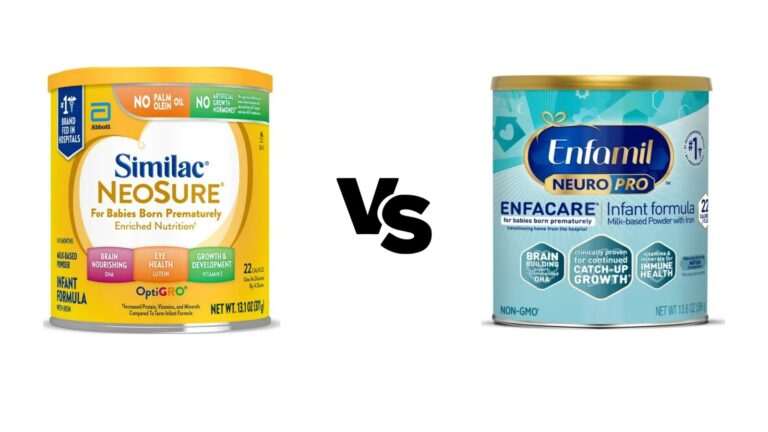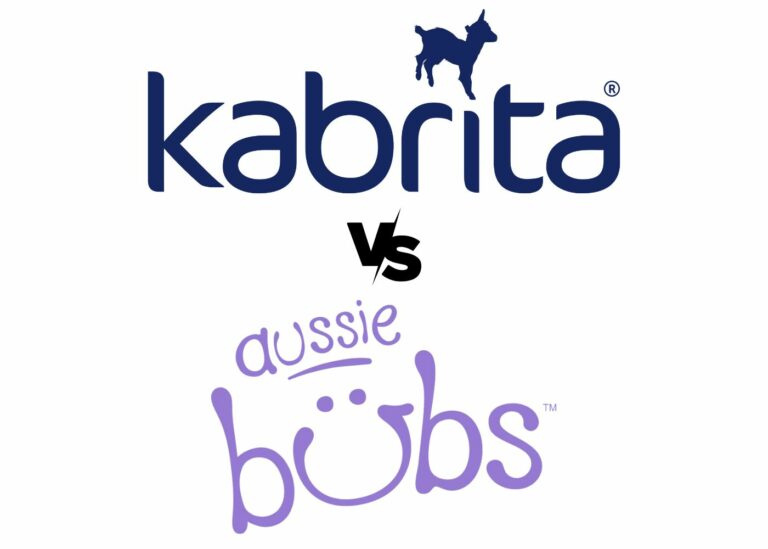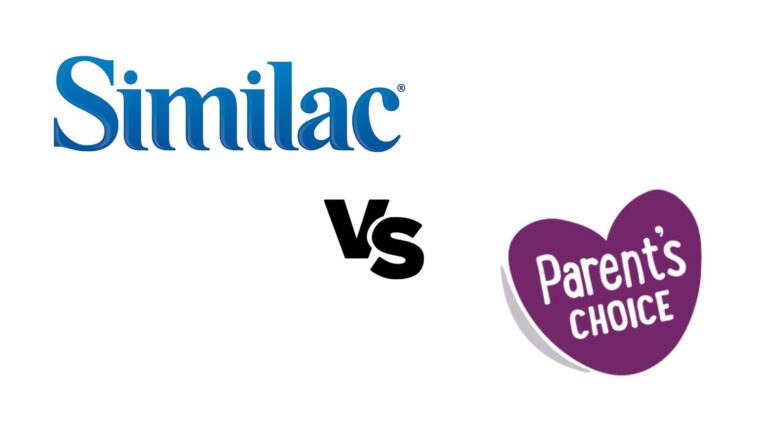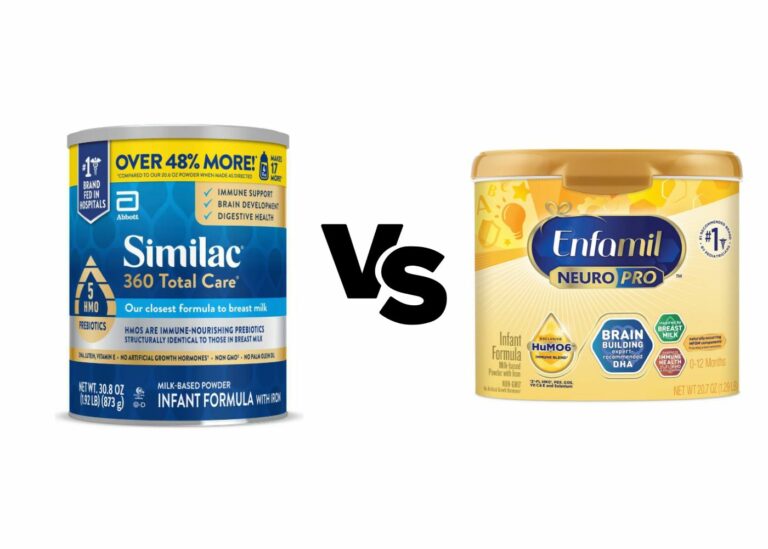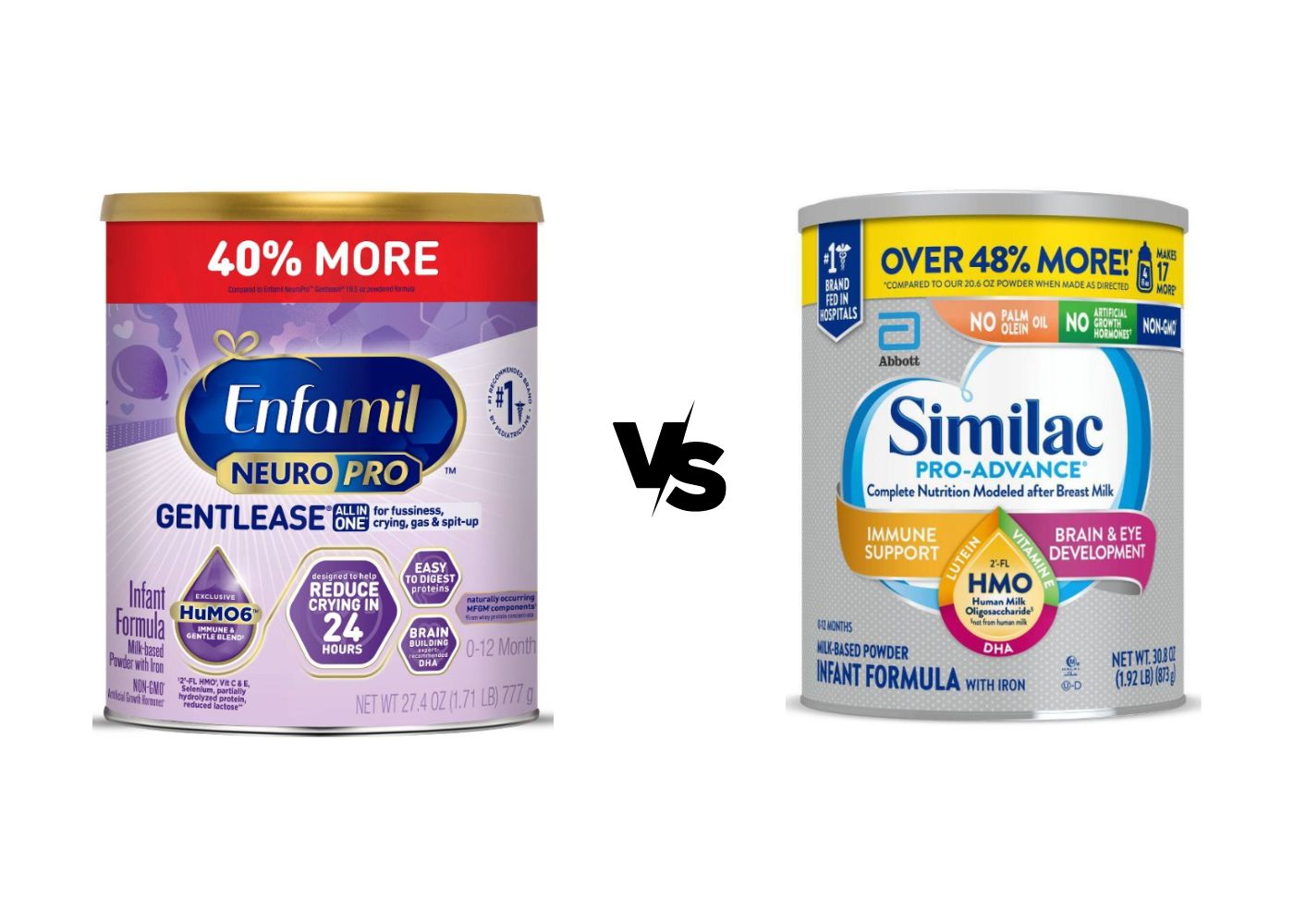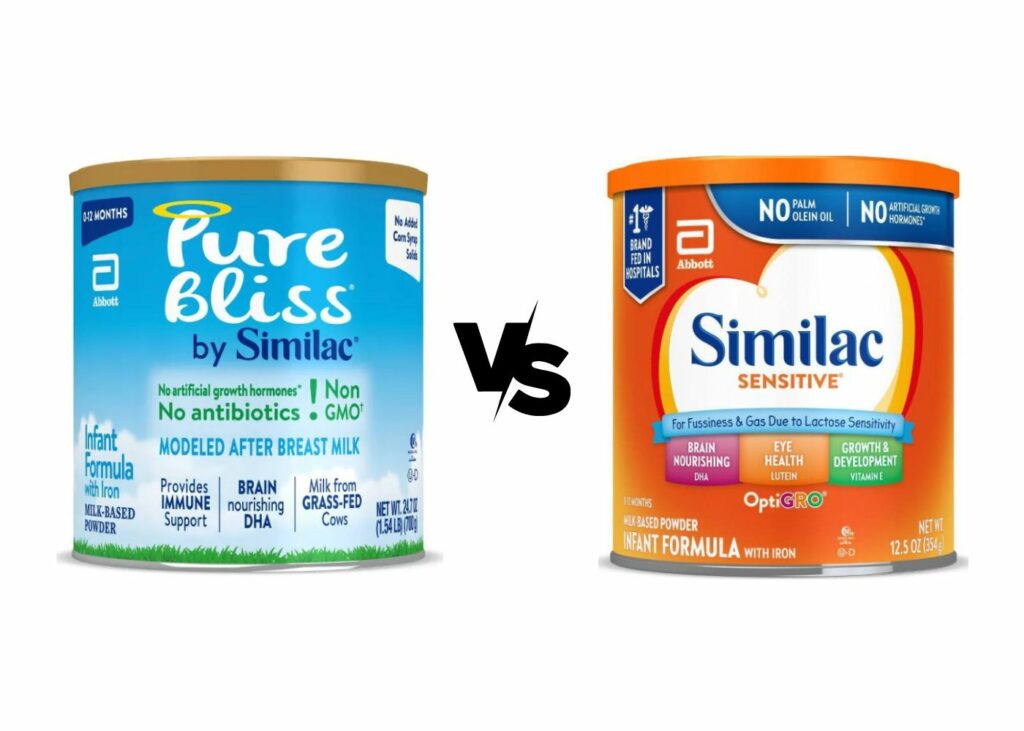
Key Differences Between Similac Sensitive and Pure Bliss
| Feature | Similac Pure Bliss | Similac Sensitive |
|---|---|---|
| Primary Purpose | Resembles breast milk, general nutrition | For lactose-sensitive babies |
| Protein Source | Nonfat milk and whey concentrate | Milk protein isolate |
| Carbohydrate Source | Lactose | Corn syrup solids |
| Fat Sources | High oleic sunflower, soy, coconut oil | High oleic safflower, soy, coconut oil |
| Prebiotics | Galactooligosaccharides | Galactooligosaccharides |
| Probiotics | None | None |
| Artificial Hormones | None | None |
| GMO-Free | Yes | Yes |
Blwstore is supported by its audience. When you buy through links on our site, we may earn an affiliate commission.
This article compares two popular Similac formulas: Similac Sensitive vs Pure Bliss.
We will analyze their ingredients and nutritional compositions to help you make an informed decision for your baby.
Let’s get after it!
Related read: Similac Pure Bliss vs Alimentum
Our Short Answer
Although we consider Similac Pure Bliss to be a better formula, you cannot make a decision between the two without considering your baby’s needs first, as both formulas are designed for different types of babies.
First of all, if your baby has allergies or severe lactose intolerance, it is better to look for other alternatives like the ones in this article.
You should only choose Similac Sensitive if your baby has lactose sensitivities.
Pure Bliss is a purer formula and closer to breast milk, but it is not suitable for babies with lactose problems.
Regardless of which one you choose, we recommend you take a look at the alternatives below in the article.
What about Pure Bliss vs Similac Pro-Sensitive?
The only difference between Similac Sensitive and Pro Sensitive is that the Pro version (Similac Pro-Sensitive) adds 2′-FL HMO, which is a prebiotic found in breast milk. Making it a better formula overall, but not enough to change our above answer.
Learn more: Similac Sensitive vs Pro-Sensitive
And Pure Bliss vs 360 Total Care Sensitive?
Similac 360 Total Care Sensitive adds HMOs or Human Milk Oligosaccharides, a series of prebiotics found in breast milk that are very beneficial to babies’ microbiota. Apart from that, it is the same formula as Similac Sensitive.
Learn more. Similac Sensitive vs 360 Total Care Sensitive
At BLWStore, we may earn a commission from some of the products featured on our website through affiliate partnerships with retailers. We want to be transparent with our readers and let you know that we do not receive any products for special consideration. The commission we earn helps support our website and allows us to continue providing helpful information and product recommendations. Thank you for your support!
Overview of the Two Formulas
Similac Pure Bliss mimics breast milk, sourced from grass-fed cows, lacks artificial hormones, antibiotics, palm olein oil, and is non-GMO. Provides comprehensive nutrition, meeting various dietary requirements.
Similac Sensitive offers easy digestion, suitable for sensitive tummies, and addresses fussiness, gas, and mild spit-up. It’s lactose-sensitive, containing DHA and lutein for brain and eye development.
Similac Pure Bliss
Similac Pure Bliss is a baby formula that boasts easy digestion and a gentle touch on baby tummies. This one is created to closely resemble breast milk, which is pretty interesting.
What stands out about this formula is that it is made with milk from grass-fed cows. The cows reside on family-owned Irish farms – freedom to graze outdoors and all. So, think happy cows.
Another plus for Similac Pure Bliss is it doesn’t contain any artificial growth hormones or antibiotics. Plus, it’s non-GMO, meaning it doesn’t contain any ingredients that have been genetically modified. The manufacturers also decided to skip on palm olein oil, which can sometimes be tricky for little tummies to digest.
Its nutritional value, sourced from different proteins, fats, and carbohydrates, aids in your baby’s growth support, fussiness, eye and brain development, gas, and immune system support. It’s also easy on those little tummies, and if dietary needs are a concern, Pure Bliss meets kosher, halal, and gluten-free dietary requirements.
Similac Sensitive
Flip the can, and you’ll find Similac Sensitive. It’s another milk-based infant formula, also designed to be easy-to-digest. Expect this formula to cater also to sensitive tummies and provide complete nutrition for fussiness, gas, and the occasional mild spit-up.
Like its Pure Bliss sibling, Similac Sensitive is also free of artificial growth hormones. It’s important noting, though, that it’s not for infants or children with galactosemia since it’s designed specifically for lactose sensitivity. So if your little one can’t stomach lactose too well, this may be for them!
Similac Sensitive supports brain and eye development thanks to DHA and lutein, nutrients found in breast milk. Plus, it has no palm olein oil and is said to support excellent calcium absorption, crucial for growing bones.
Nutritional Composition
Similac Pure Bliss contains 2.07g protein (nonfat milk and whey concentrate), 10.7g carbs (lactose), and 5.6g fat (high oleic sunflower, soy, coconut oil).
Similac Sensitive has slightly more protein (2.1g, milk protein isolate), 10.9g carbs (corn syrup), and 5.4g fat (high oleic safflower, soy, coconut oil).
They differ in protein sources, carb types (lactose vs. corn syrup), but share similar fat content and sources.
Protein Content
Each 5.3 fluid ounce serving of Similac Pure Bliss contains 2.07 grams of protein. This comes from nonfat milk and whey protein concentrate. Both sources are derived from milk, providing complete protein that includes all essential amino acids your baby needs for growth.
Similac Sensitive, on the other hand, contains marginally more protein – 2.1 grams in a 5 fluid ounce serving. The protein here comes from milk protein isolate, which is a high-quality protein source that’s easy for babies to digest.
Pure Bliss opts for skimmed milk and whey protein concentrate, the standards in conventional formulas for babies without digestive issues.
Similac Sensitive uses milk protein isolate, which is a combination of whey and casein proteins. It contains 1-2% lactose, being suitable for babies with some lactose sensitivities but not for those with severe lactose intolerance.
Carbohydrate Content
Looking at carbohydrates, Similac Pure Bliss contains about 10.7 grams per 5.3 fluid ounces serving. The main sources here are lactose, naturally found in milk. Lactose is a major source of energy and helps improve mineral absorption.
Similac Sensitive contains slightly more carbohydrates, about 10.9 grams per 5 fluid ounces. This formula opts for corn syrup as its main carbohydrate source. You see, corn syrup is a type of sugar known for its sweetness. It’s used in this product due to its ability to be broken down easily, aiding those with sensitive tummies.
Both formulas differ in their carb source because they are designed for different type of babies.
Pure Bliss uses lactose exclusively, which is what we like to see in an ordinary formula.
Sensitive, however, uses corn syrup solids, an ingredient that replaces lactose used mostly in US-based formulas. It is a suitable substitute, but there are better alternatives like starch or maltodextrin. Similac Sensitive has an insignificant amount of lactose because it is designed for babies with lactose sensitivities.
Learn more: Corn Syrup in Baby Formulas
Fats and Oils
In the fat department, Similac Pure Bliss delivers 5.6 grams per 5.3 fluid ounces serving. It derives its fat from high oleic sunflower oil, soy oil, and coconut oil. High oleic sunflower oil is high in unsaturated fat and low in saturated fat. Soy oil contains omega-3 fatty acids, while coconut oil provides medium-chain triglycerides (MCTs), which are quickly absorbed and utilized for energy.
Similac Sensitive provides slightly less fat, about 5.4 grams per 5 fluid ounces serving. Its fats come from high oleic safflower oil, soy oil, and coconut oil. High oleic safflower oil, like high oleic sunflower oil, is rich in monounsaturated fats. Both the soy and coconut oils bring the same benefits as in the Pure Bliss formula.
There are no differences in fat content whatsoever. Similac uses the same fat blend for almost every single one of its formulas.
Probiotics and Prebiotics
Both formulas contain galactooligosaccharides and no probiotics.
In both Similac Pure Bliss and Similac Sensitive, you’ll notice a term popping up: galactooligosaccharides. This is a prebiotic fiber found in breast milk that feeds the good bacteria in a baby’s gut, helping to support their little immune systems. Prebiotics are like food for the good bacteria in the gut, and having them in a formula can be beneficial.
It’s also important to note that although these formulas contain prebiotics, they do not include probiotics. Probiotics are live bacteria and yeasts that are good for health, especially the digestive system. Some formulas incorporate them, but in these cases, Similac has opted to stick with prebiotics.
Best Places to Buy Similac Pure Bliss and Sensitive


Similac Pure Bliss
Buy Similac Pure Bliss at Target
Buy Similac Pure Bliss at Walmart
Similac Sensitive
Buy Similac Sensitive at Target
Buy Similac Sensitive at Walmart
What are the best alternatives to Similac Pure Bliss and Sensitive?
While Pure Bliss and Sensitive are high-quality formulas, there are better alternatives in the market.
Here are our favorite alternatives to Similac Pure Bliss and Similac Sensitive:
Alternatives to Similac Pure Bliss:
Kendamil Organic: Known for using organic and natural ingredients, Kendamil Organic is a worthy contender. Notably, it uses whole milk instead of skimmed, which can be beneficial for many babies. Plus, Kendamil features real human milk oligosaccharides (HMOs)— the stuff you’ll find in real breast milk. No artificial HMOs here.
Bobbie: If you’re looking for an option from a US brand, Bobbie might be your best match. Its key selling points include a pure and simple ingredient list, focusing on the important stuff without all the unnecessary extras.
Alternatives to Similac Sensitive:
Hipp HA: This stands out as one of the best hypoallergenic formulas in the market. It’s designed for babies who have an allergic reaction to the protein in cow’s milk.
Hipp AR: This formula is meant for babies who tend to regurgitate their formula or have reflux issues. It contains a special ingredient that helps the formula to stay in your little one’s stomach.
Hipp Comfort: Finally, Hipp Comfort is a formula specifically designed for babies with digestive issues and lactose sensitivities. It contains modified milk protein and low lactose to make digestion easier.
Last Words
We hope this comparison between Similac Pure Bliss and Sensitive has helped you make the best decision for your baby.
We recommend you to read about the alternatives above before purchasing anything
Happy feeding!
We’re Maria and Alberto, a married couple and educators who are nutrition enthusiasts. Even before we had kids, we were already crazy about nutrition.
We’d read scientific articles, watch videos from nutritionists, and spend hours listening to nutrition podcasts.
Today, we continue doing this, but in a different way, as we’ve learned to sift through the noise and trends. Nutrition, like any other field of knowledge, the more you read and learn, the more you develop a comprehensive understanding of reality, and that’s what has happened to us.
Before having our first child, we focused on learning everything we could about child nutrition, using the same techniques we had already employed, backed by our extensive knowledge in nutrition.
Our mission is to help other parents with their children’s nutrition, to help them become the best versions of themselves.
If we are what we eat and drink, which is absolutely true, let’s do it right!


